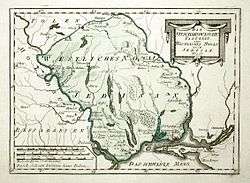Yedisan

In the 17th and 18th centuries, Yedisan (also Jedisan or Edisan) was the western part of the Wild Fields that sprawled to the north of the Black Sea between the Dniester and Dnieper rivers. It was east of Budjak and Moldavia, south of Podolia and Zaporizhia, and west of Taurida. Since the mid-20th century, the territory has been divided between southwestern Ukraine and southeastern Moldova (southern Transnistria).
The region is named for the Yedisan sept of the Nogai Horde. It was also referred to as Nogai Tartary or West Nogai, as the Yedisans were Nogai Tatars living in the west of Little Tartary. "Yedisan" is Turkic for "Seven Titles", doubtless the sept was made up of seven subgroups. Yedisan was also sometimes referred to as Ochakov Tartary after Ochakov (Ochakiv), the main fortress of the region. Names for the region in different language include: Ukrainian: Єдісан [Yedisan]; Russian: Едисан [Yedisan]; Romanian: Edisan; Crimean Tatar and Turkish: Yedisan; German: Jedisan; Polish: Jedysan.
In the early medieval period, Yedisan was home to Ulichs, Pechenegs, and later Cumans (Polovtsians). Following the Mongol invasions of the thirteenth century it was under control of the Khanate of the Golden Horde. In the fifteenth century it fell to the Grand Duchy of Lithuania (when it was known as Dykra) then later to the Ottoman Empire’s vassal state, the Crimean Khanate. The nomadic Nogais began to inhabit the region after being forced first from Central Asia to the Kuban region. From there, one of the hordes moved westward after 1724 and gave its name to Yedisan, although Yedisan is anachronistically marked as such before the arrival of the Nogais on many contemporary historical maps.
The area at times was incorporated into the Ottoman administrative structure as part of Silistra (Özi) Eyalet with the fortresses of Khadjibey (Odessa) and Özi (Ochakiv) as major centers. It was also part of a larger nomadic conflict between the Nogais who were clients of the Ottoman Porte and the Russian-sponsored Zaporizhian Cossacks. In the late 18th century, Imperial Russia under Catherine the Great began to expand into the area. As a result of the Russo-Turkish War of 1768-1774, the Ottomans ceded to Russia the region east of the Southern Bug.
Through the 1792 Treaty of Jassy (Iaşi) which concluded the Russo-Turkish War of 1787-1792, the Russian frontier was extended to the Dniester River and the takeover of Yedisan was complete. Following the Russian takeover, the city of Odessa was founded in 1794 and the area was settled as part of New Russia by Moldavian, Russian and Ukrainian colonists along with a significant German element. The area came to form parts of the Kherson Governorate and is now part of the Ukrainian Odessa and Mykolaiv oblasts.